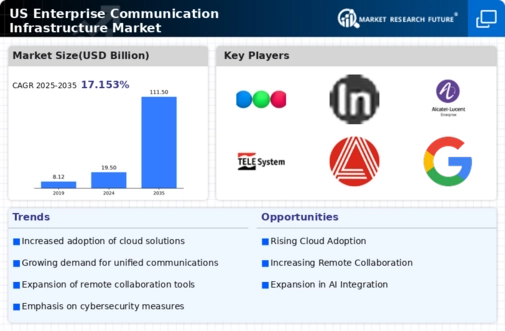The enterprise communication-infrastructure market is characterized by a dynamic competitive landscape, driven by the increasing demand for seamless communication solutions across various sectors. Key players such as Microsoft (US), Cisco Systems (US), and Zoom Video Communications (US) are at the forefront, each adopting distinct strategies to enhance their market positioning. Microsoft (US) focuses on integrating its communication tools with its broader suite of productivity applications, thereby fostering a cohesive user experience. Cisco Systems (US) emphasizes innovation through its robust portfolio of security and collaboration tools, while Zoom Video Communications (US) continues to expand its offerings beyond video conferencing, venturing into areas like event management and customer engagement solutions. Collectively, these strategies contribute to a competitive environment that is increasingly centered on technological advancement and user-centric solutions.
In terms of business tactics, companies are increasingly localizing their operations and optimizing supply chains to enhance efficiency and responsiveness. The market structure appears moderately fragmented, with several players vying for market share, yet dominated by a few key firms that wield considerable influence. This competitive structure allows for a diverse range of offerings, catering to various customer needs while fostering innovation through competition.
In October 2025, Microsoft (US) announced the launch of its new AI-driven communication platform, which integrates advanced analytics and machine learning capabilities to enhance user engagement. This strategic move is significant as it positions Microsoft (US) to leverage AI technology, potentially transforming how enterprises manage communication and collaboration. The integration of AI not only streamlines operations but also provides valuable insights into user behavior, thereby enhancing decision-making processes.
In September 2025, Cisco Systems (US) unveiled a partnership with a leading cybersecurity firm to bolster its communication infrastructure's security features. This collaboration is crucial, as it addresses the growing concerns around data privacy and security in enterprise communications. By enhancing its security offerings, Cisco Systems (US) not only strengthens its market position but also reassures clients about the safety of their communications, which is increasingly paramount in today’s digital landscape.
In August 2025, Zoom Video Communications (US) expanded its product suite by acquiring a prominent customer engagement platform. This acquisition is indicative of Zoom's strategy to diversify its offerings and create a more comprehensive communication ecosystem. By integrating customer engagement tools, Zoom Video Communications (US) aims to provide a seamless experience for businesses, thereby enhancing customer satisfaction and loyalty.
As of November 2025, current trends in the enterprise communication-infrastructure market are heavily influenced by digitalization, sustainability, and the integration of AI technologies. Strategic alliances are becoming increasingly vital, as companies recognize the need to collaborate to enhance their service offerings and market reach. Looking ahead, competitive differentiation is likely to evolve, shifting from traditional price-based competition to a focus on innovation, technological advancements, and supply chain reliability. This transition underscores the importance of adaptability and forward-thinking strategies in maintaining a competitive edge in a rapidly changing market.

















Leave a Comment